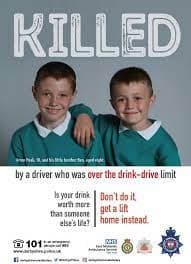As we are now in the middle of the immediate Christmas period, we are turning our attention once again to alcohol, because, as parties and celebrations continue, especially for New Year, it is important to stress that when it comes to driving, the only safe level of alcohol is ZERO.
Alcohol is one of the risk factors most frequently involved in traffic incidents and collisions, and because the consumption of alcohol is a choice, that factor which is present in between 30% and 50% of fatal incidents can so easily be avoided. In other words, many deaths and serious life-changing injuries can be avoided if we all consume alcohol responsibly and never drive under the influence.
Alcohol is a psychoactive substance very present in our society, its consumption is associated with multiple and serious pathologies. It is a problem about which there is not enough awareness in relation to the harm it causes, both in terms of health and in family, work, social relationships, etc. There is a dose-response relationship between alcohol consumption and the frequency and severity of many diseases. At higher levels of consumption, there is a higher rate of certain diseases such as liver cirrhosis, or some types of cancer, and of work, domestic and traffic incidents.
Alcohol is a depressant of the Central Nervous System that alters both the ability and attitude to drive and increases the risk of being involved in a traffic incident. In its first phase, it produces a euphoric effect, which leads to loss of control, reduces the perception of risk, modifies behaviour, and impairs psychomotor function, all of which alters the ability to drive a vehicle.
There is a perception that incident risk is only associated with very high levels of consumption, but its negative effects on driving ability are observed even at low levels of consumption. As the amount of alcohol in the body increases, so does the risk of an incident: with a blood alcohol level of 0.5 g of ethanol per litre of blood, the risk of suffering a collision is multiplied by two, and with 0.8 g /l the risk is 5 times greater and continues to increase as the blood alcohol level increases. Not only does the risk of suffering an incident increase, so does the risk of suffering injuries and the likelihood of them being fatal.
The risk is even greater in young drivers, where inexperience with alcohol is combined with inexperience in driving, a fact that justifies the legislator having established in the norm, lower alcohol levels for novice drivers, and a zero rate for minors, although, again, the only safe level is zero for all drivers.
We should also realise that if drinking and driving becomes habitual, it is only a matter of time before you are involved in an incident. Routine leads to complacency, complacency leads to risk, added to the already present diminished ability the alcohol causes.
The blood alcohol level represents the volume of alcohol in the blood and is measured in grams of alcohol per litre of blood (g/l) or its equivalent in exhaled air.
According to current legislation, the maximum blood alcohol levels allowed for drivers in Spain are the:
- General drivers: 0,5 g/l of blood, 0,25 mg/l expelled air.
- Novice and professional drivers: 0,3 g/l of blood, 0,15 mg/l expelled air.
- Minors: Zero.
Even below the legal limit, the risk of an incident will already be increased. Therefore, it is best to avoid driving after consuming any amount of alcohol. The only truly safe rate is 0.0 g/l.

The post Don’t Drink and Drive! first appeared on N332.es – Driving In Spain.




